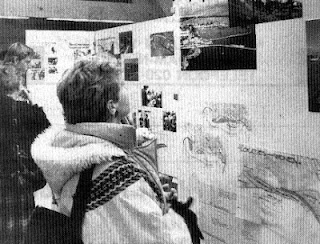A B O U T
In 1989 I was asked, as an artist, to install an exhibition
about the Amsterdam
IJ-borders. It meant to be a historic overview and I only had eight weeks to
realize it. An impossible job if it wasn’t that I had studied archeology for a
while and therefore knew how to do historic research. Still it wasn’t an easy
nut to crack in that time period.
I wasn’t the only one who was aware of this. Some amateur
historians, who were involved in the project, called it nonsense to invite an
artist to clear the job, and they were quit surprised when the end-result was
much more then they expected.
At the beginning it was just an extra and paid order for me.
I only lived three years in Amsterdam ,
and didn’t know much more about the city – and especially the IJ – than someone
else who lived there for such a short period, but I knew my way in historical
archives, managed to dig up what I needed and to illustrate the exhibition.
Especially the historians were surprised, and admitted this. I was asked to
stay with the project which wasn’t just a one time historical illustration of Amsterdam ’s important
sea-gate.
The IJ divides the city in two: the old part with the town
center and 19th century quarters on the south side and the former
agricultural and industrial quarters in the North. This was the capitals
stepchild, however close to the center but divided by the IJ it wasn’t easy to
approach. A couple of –free- ferries made it possible to cross but the border
alongside was mainly a composition of the old and long gone shipyard activity
and some pre-fabricated housing facilities. It had to be modernized to cope
with the south border and to become really a part of the Amsterdam agglomeration. A group of people
saw this and formed the Noordzij (North side) association to work at the
realization of re-structuring the northern border. The exhibition, in which I
was involved, was just part of a festival to launch the idea among a broader
audience.
After my successful introduction I was asked to stay and
guide the cultural events the association had planned for the future. I became
the official exhibition coordinator, and later the vice-president of the club
which wanted to work to an end-conclusion in order to bring attention to the
re-structuring of the northern border towards the city and council of Amsterdam .
E V E N T S
Noordzij festival
The first festival was strictly cultural, just to bring
attention to the subject. The exhibition I was responsible for, and another,
done by a different artist which showed artistic views around the IJ-border.
Besides the two exhibitions, which were the center of the festival, a lot of
street acts were performed, photographed and documented by Kors van Bennekom.
Meetings
The goal was to organize meetings in order to grab as much
as possible ideas and to create an as broad as possible basis in the area.
People have to know and to understand why changes have to evolve if you want
them to support. The association brought those meetings as close to the audience
as possible, organizing in cultural centrums and hotels nearby. Participation
was as broad as one could expect: people who lived in the neighborhood,
entrepreneurs and local politicians. New ideas were brought in and the
discussion around re-structuring came to surface. Based on these meetings an
end-conclusion would finally be formulated and brought to attention of the
responsible governmental services.
Exhibition in the ferry office
The organization started in one of the cultural centers
which was only a temporary location, but moved to the former ferry-office. A
headquarters was formed with a small permanent staff and I was asked to
celebrate the new location with an exhibition which showed the results so far.
Tolhuis exhibition
Every initiative located on the border of the IJ was used to
give more attention to the project. When Tolhuis, a restaurant and former
toll-office, was renovated, the inauguration was a perfect reason to put the
Noordzij association in the spotlights again. A meeting was organized framed by
an exhibition around the plans and realizations by the organization as was
achieved. It was a first preparation for the community to make them aware of
the possible results as would be formulated in the end-conclusion.
Springtij festival
Like a pyramid all the effort came together in a one time
and extremely large festival to celebrate the results of, in total, four years
of hard work. In the summer of 1993 the Springtij (spring-tide) festival was
organized with exhibitions on both sides of the IJ, discussion meetings in
boats on the IJ itself, enlightened with all kinds of street manifestations and
performances. Architectural plans for both the borders were shown. The
end-conclusion was a fact, however not printed yet, but the recommendations
were already addressed to the proper institutions. The festival was a gigantic
success with a lot of media attention and visitors. It underlined everything
the association stood and had worked for.
End conclusion
The end-conclusion was presented in a booklet of over a
hundred pages text and photos. I was asked to do the layout to make it as
attractive as possible. It was something to be proud of, and a lot of the ideas
formulated came actually to plans and are realized in the mean time. If you compare
the northern border today by almost 20 years ago you see the differences and
the huge change the formally industrial Amsterdam
IJ-borders went through.






Geen opmerkingen:
Een reactie posten